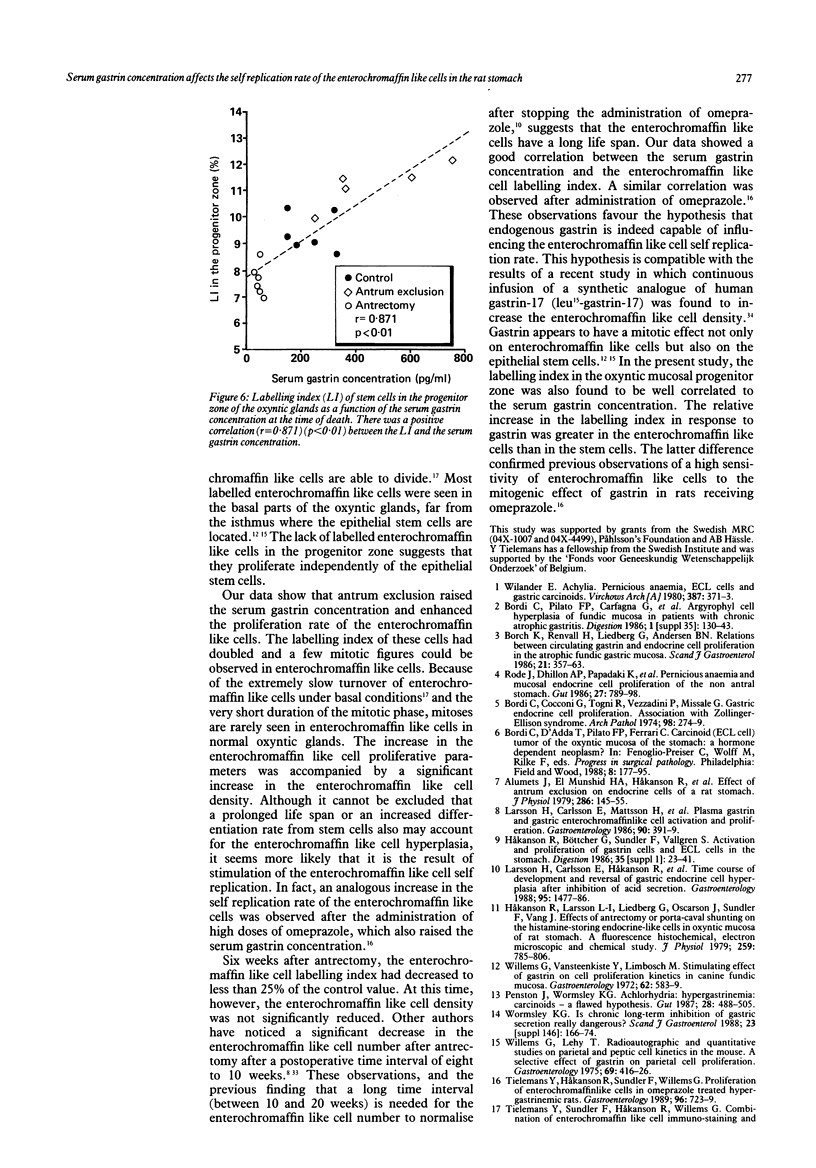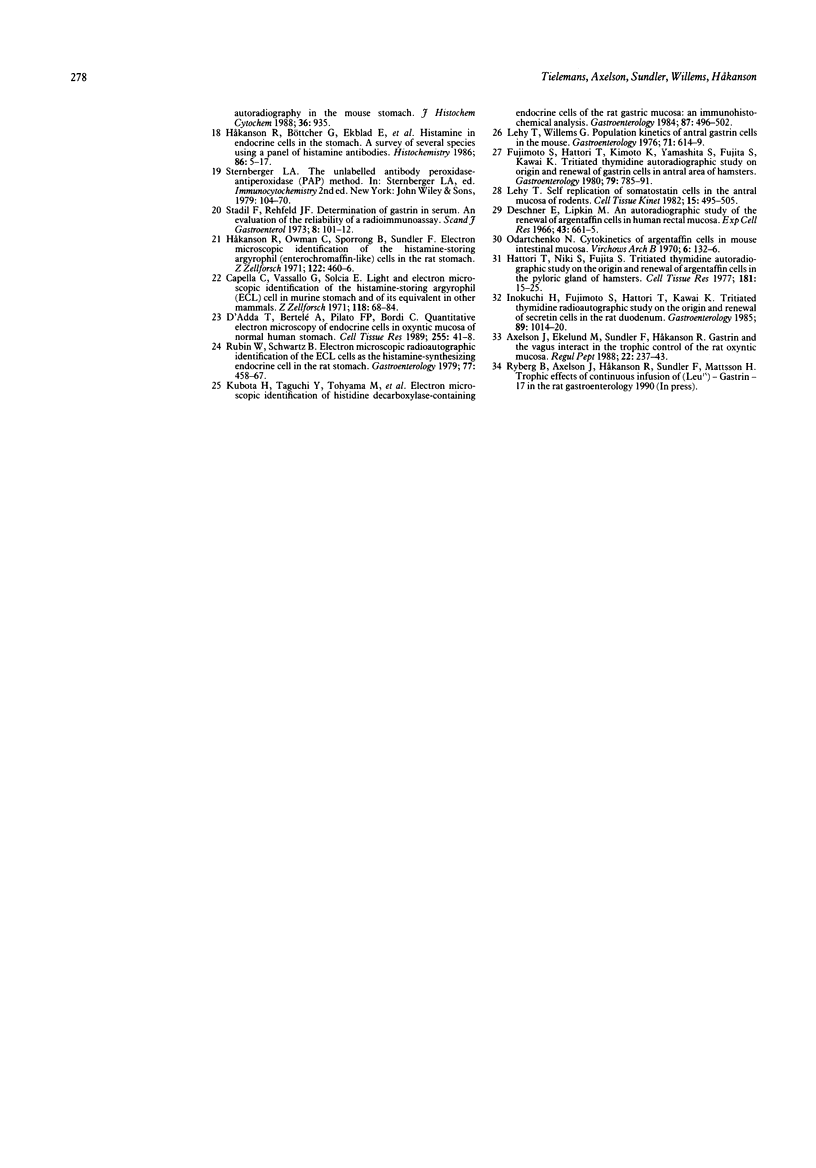Abstract
The influence of antrectomy and antrum exclusion on the enterochromaffin like cell kinetics in the gastric mucosa of the rat was studied using a combination of histamine immunocytochemistry and autoradiography after in vivo labelling with tritiated thymidine. In all experimental groups, the enterochromaffin like cells were found to incorporate the DNA precursor, thus indicating an ability to divide. The serum gastrin concentration was raised by antrum exclusion and reduced by antrectomy. After antrum exclusion, the enterochromaffin like cell proliferation rate increased as indicated by a doubling of the labelling index and by the resulting enterochromaffin like cell hyperplasia (after six weeks). After antrectomy, the enterochromaffin like cell labelling index decreased to reach 25% of the control value; at this time the enterochromaffin like cell density had not decreased significantly. The observed correlation between the enterochromaffin like cell labelling indices and the serum gastrin concentration supports the hypothesis that enterochromaffin like cell proliferation is influenced by serum gastrin.
Full text
PDF




Selected References
These references are in PubMed. This may not be the complete list of references from this article.
- Alumets J., El Munshid H. A., Håkanson R., Liedberg G., Oscarson J., Rehfeld J. F., Sundler F. Effect of antrum exclusion on endocrine cells of rat stomach. J Physiol. 1979 Jan;286:145–155. doi: 10.1113/jphysiol.1979.sp012610. [DOI] [PMC free article] [PubMed] [Google Scholar]
- Axelson J., Ekelund M., Håkanson R., Sundler F. Gastrin and the vagus interact in the trophic control of the rat oxyntic mucosa. Regul Pept. 1988 Aug;22(3):237–243. doi: 10.1016/0167-0115(88)90036-5. [DOI] [PubMed] [Google Scholar]
- Borch K., Renvall H., Liedberg G., Andersen B. N. Relations between circulating gastrin and endocrine cell proliferation in the atrophic gastric fundic mucosa. Scand J Gastroenterol. 1986 Apr;21(3):357–363. doi: 10.3109/00365528609003087. [DOI] [PubMed] [Google Scholar]
- Bordi C., Cocconi G., Togni R., Vezzadini P., Missale G. Gastric endocrine cell proliferation. Association with Zollinger-Ellison syndrome. Arch Pathol. 1974 Oct;98(4):274–278. [PubMed] [Google Scholar]
- Bordi C., Pilato F., Carfagna G., Ferrari C., D'Adda T., Sivelli R., Bertelé A., Missale G. Argyrophil cell hyperplasia of fundic mucosa in patients with chronic atrophic gastritis. Digestion. 1986;35 (Suppl 1):130–143. doi: 10.1159/000199389. [DOI] [PubMed] [Google Scholar]
- Capella C., Vassallo G., Solcia E. Light and electron microscopic identification of the histamine-storing argyrophil (ECL) cell in murine stomach and of its equivalent in other mammals. Z Zellforsch Mikrosk Anat. 1971;118(1):68–84. doi: 10.1007/BF00331767. [DOI] [PubMed] [Google Scholar]
- D'Adda T., Bertelé A., Pilato F. P., Bordi C. Quantitative electron microscopy of endocrine cells in oxyntic mucosa of normal human stomach. Cell Tissue Res. 1989 Jan;255(1):41–48. doi: 10.1007/BF00229064. [DOI] [PubMed] [Google Scholar]
- Deschner E. E., Lipkin M. An autoradiographic study of the renewal of argentaffin cells in human rectal mucosa. Exp Cell Res. 1966 Oct;43(3):661–665. doi: 10.1016/0014-4827(66)90038-3. [DOI] [PubMed] [Google Scholar]
- Fujimoto S., Hattori T., Kimoto K., Yamashita S., Fujita S., Kawai K. Tritiated thymidine autoradiographic study on origin and renewal of gastrin cells in antral area of hamsters. Gastroenterology. 1980 Nov;79(5 Pt 1):785–791. [PubMed] [Google Scholar]
- Hattori T., Niki H., Fujita S. Tritiated thymidine autoradiographic study on the origin and renewal of argentaffin cells in the pyloric gland of hamsters. Cell Tissue Res. 1977 Jun 20;181(1):15–25. doi: 10.1007/BF00222771. [DOI] [PubMed] [Google Scholar]
- Häkanson R., Larsson L. I., Liedberg G., Oscarson J., Sundler F., Vang J. Effects of antrectomy or porta-caval shunting on the histamine-storing endocrine-like cells in oxyntic mucosa of rat stomach. A fluorescence histochemical, electron microscopic and chemical study. J Physiol. 1976 Aug;259(3):785–800. doi: 10.1113/jphysiol.1976.sp011495. [DOI] [PMC free article] [PubMed] [Google Scholar]
- Håkanson R., Böttcher G., Ekblad E., Panula P., Simonsson M., Dohlsten M., Hallberg T., Sundler F. Histamine in endocrine cells in the stomach. A survey of several species using a panel of histamine antibodies. Histochemistry. 1986;86(1):5–17. doi: 10.1007/BF00492340. [DOI] [PubMed] [Google Scholar]
- Håkanson R., Böttcher G., Sundler F., Vallgren S. Activation and hyperplasia of gastrin and enterochromaffin-like cells in the stomach. Digestion. 1986;35 (Suppl 1):23–41. doi: 10.1159/000199380. [DOI] [PubMed] [Google Scholar]
- Håkanson R., Owman C., Sporrong B., Sundler F. Electron microscopic identification of the histamine-storing argyrophil (enterochromaffin-like) cells in the rat stomach. Z Zellforsch Mikrosk Anat. 1971;122(4):460–466. doi: 10.1007/BF00936080. [DOI] [PubMed] [Google Scholar]
- Inokuchi H., Fujimoto S., Hattori T., Kawai K. Tritiated thymidine radioautographic study on the origin and renewal of secretin cells in the rat duodenum. Gastroenterology. 1985 Nov;89(5):1014–1020. doi: 10.1016/0016-5085(85)90202-1. [DOI] [PubMed] [Google Scholar]
- Kubota H., Taguchi Y., Tohyama M., Matsuura N., Shiosaka S., Ishihara T., Watanabe T., Shiotani Y., Wada H. Electron microscopic identification of histidine decarboxylase-containing endocrine cells of the rat gastric mucosa. An immunohistochemical analysis. Gastroenterology. 1984 Sep;87(3):496–502. [PubMed] [Google Scholar]
- Larsson H., Carlsson E., Håkanson R., Mattsson H., Nilsson G., Seensalu R., Wallmark B., Sundler F. Time-course of development and reversal of gastric endocrine cell hyperplasia after inhibition of acid secretion. Studies with omeprazole and ranitidine in intact and antrectomized rats. Gastroenterology. 1988 Dec;95(6):1477–1486. doi: 10.1016/s0016-5085(88)80066-0. [DOI] [PubMed] [Google Scholar]
- Larsson H., Carlsson E., Mattsson H., Lundell L., Sundler F., Sundell G., Wallmark B., Watanabe T., Håkanson R. Plasma gastrin and gastric enterochromaffinlike cell activation and proliferation. Studies with omeprazole and ranitidine in intact and antrectomized rats. Gastroenterology. 1986 Feb;90(2):391–399. doi: 10.1016/0016-5085(86)90938-8. [DOI] [PubMed] [Google Scholar]
- Lehy T. Self-replication of somatostatin cells in the antral mucosa of rodents. Cell Tissue Kinet. 1982 Sep;15(5):495–505. doi: 10.1111/j.1365-2184.1982.tb01572.x. [DOI] [PubMed] [Google Scholar]
- Lehy T., Willems G. Population kinetics of antral gastrin cells in the mouse. Gastroenterology. 1976 Oct;71(4):614–619. [PubMed] [Google Scholar]
- Penston J., Wormsley K. G. Achlorhydria: hypergastrinaemia: carcinoids--a flawed hypothesis? Gut. 1987 Apr;28(4):488–505. doi: 10.1136/gut.28.4.488. [DOI] [PMC free article] [PubMed] [Google Scholar]
- Rode J., Dhillon A. P., Papadaki L., Stockbrügger R., Thompson R. J., Moss E., Cotton P. B. Pernicious anaemia and mucosal endocrine cell proliferation of the non-antral stomach. Gut. 1986 Jul;27(7):789–798. doi: 10.1136/gut.27.7.789. [DOI] [PMC free article] [PubMed] [Google Scholar]
- Rubin W., Schwartz B. Electron microscopic radioautographic identification of the ECL cell as the histamine-synthesizing endocrine cell in the rat stomach. Gastroenterology. 1979 Sep;77(3):458–467. [PubMed] [Google Scholar]
- Stadil F., Rehfeld J. F. Determination of gastrin in serum. An evaluation of the reliability of a radioimmunoassay. Scand J Gastroenterol. 1973;8(2):101–112. [PubMed] [Google Scholar]
- Tielemans Y., Håkanson R., Sundler F., Willems G. Proliferation of enterochromaffinlike cells in omeprazole-treated hypergastrinemic rats. Gastroenterology. 1989 Mar;96(3):723–729. [PubMed] [Google Scholar]
- Wilander E. Achylia, pernicious anaemia, ECL cells and gastric carcinoids. Virchows Arch A Pathol Anat Histol. 1980;387(3):371–373. doi: 10.1007/BF00454839. [DOI] [PubMed] [Google Scholar]
- Willems G., Lehy T. Radioautographic and quantitative studies on parietal and peptic cell kinetics in the mouse. A selective effect of gastrin on parietal cell proliferation. Gastroenterology. 1975 Aug;69(2):416–426. [PubMed] [Google Scholar]
- Willems G., Vansteenkiste Y., Limbosch J. M. Stimulating effect of gastrin on cell proliferation kinetics in canine fundic mucosa. Gastroenterology. 1972 Apr;62(4):583–589. [PubMed] [Google Scholar]
- Wormsley K. G. Is chronic long-term inhibition of gastric secretion really dangerous? Scand J Gastroenterol Suppl. 1988;146:166–174. doi: 10.3109/00365528809099143. [DOI] [PubMed] [Google Scholar]


